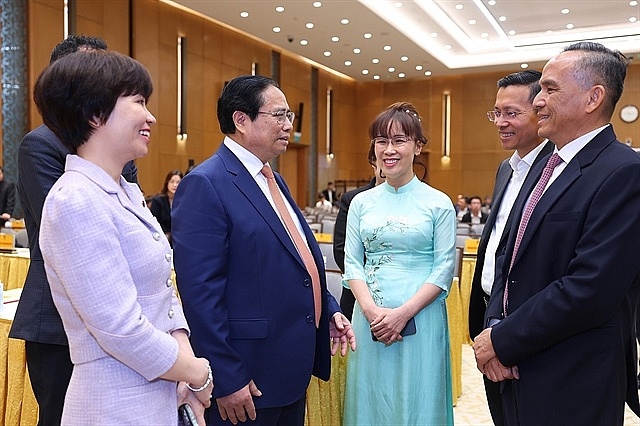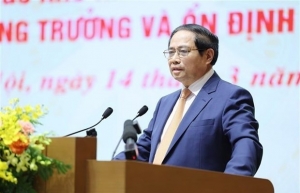PM urges further rate cuts, improved credit access to remove obstacles, promote growth
 |
| Prime Minister Phạm Minh Chính (second, left) talks with businesses at the conference to implement monetary management tasks on Thursday. - VNA/VNS Photo Dương Giang |
Hanoi - Prime Minister Phạm Minh Chính urges efforts to lower lending rates and improve credit access and absorption capacity to remove difficulties for production and business and accelerate growth.
Chính was speaking at the conference to implement monetary policy management tasks in 2024 on Thursday in Hanoi.
The focus of the monetary policy management will be on “five increases”, “five reductions” and “five accelerations”, he stressed.
Five increases include improving credit access and absorption capacity, especially for small and medium–sized enterprises (SMEs), hastening efforts to remove legal bottlenecks and improve credit quality, enhancing coordination between banks and enterprises, increasing transparency in rates, and increasing supervision to prevent risks and corruption.
Five reductions include lowering lending rates, lowering transaction and operation costs, simplifying administrative procedures, reducing cases of intentional obstruction, and reducing disruptions.
Five accelerations include breakthroughs in digitalisation, service quality, human resource quality, banking infrastructure and promoting credit flow into production and business to create jobs and promote economic growth.
These solutions aim to address problems in implementing monetary policy after lower-than-expected credit growth in the first month of this year despite a significant amount of deposits at banks, estimated at more than VND13.6 quadrillion.
In addition, the reductions in lending rates are not commensurate with the decrease in deposit rates. Enterprises still struggle to access credit and rates remain high.
Bad debts tend to rise while the implementation of some credit support packages is disappointing.
Statistics of the State Bank of Vietnam showed that credit dropped 0.72 per cent in the first two months of this year against the end of 2023 after posting a rise of 13.78 per cent in 2023.
With the huge amount of deposits at banks, there is significant room to increase lending, Deputy Governor Dao Minh Tu said.
Tú pointed out reasons for low credit growth, including unpredictable global economic development weighing on exchange rates, low capital absorption capacity of enterprises and the entire economy on rising inflation, input costs, shortage of order and tightening spending.
A notable problem is that enterprises have demand for borrowing but cannot meet the requirements, especially SMEs.
Legal bottlenecks are also hindering the disbursement of credit support packages such as the VND120 trillion for social housing development.
Banks are also cautious about providing lending because bad debts are rising.
The capital demand is weighing on the financial and monetary system while other capital raising channels continue struggling, especially the corporate bond market.
Enterprises’ voices
Le Tien Truong, chairman of Vietnam National Textile and Garment Group, said the development of monetary policies should refer to other countries’ policies to enhance competitiveness for export industries.
In terms of exchange rates, Vietnam’s garment products are around 15 per cent higher than other major exporters such as Turkey, Bangladesh and China, which had devalued their currencies significantly in 2022-23 to aid exports, by 50 per cent, 21 per cent and 11 per cent, respectively. In comparison, the Vietnamese đồng devaluated by more than 3 per cent.
Lending rates in Vietnam are also higher. For Vinatex, lending rates are around 7-9 per cent, compared to the general rate of around 3.5 per cent in other countries.
Truong said that the textile industry is facing significant difficulty and in dire need of support for accessing capital.
Dinh Minh Truong, chairman of Sun Group, said that real estate companies expected to have access to lower-cost credit.
Currently, the difference in rates between joint stock commercial banks and State-owned commercial bank is quite large, from 4-5 per cent. The gap should be narrowed, together with reducing costs to create conditions for enterprises to overcome the difficult time, he said.
According to Quang Van Viet Cuong, deputy director of industrial and urban real estate developer Becamex, the Government is determined to remove obstacles for businesses and the determination must be spread to the local level and every individual official to ensure effective implementation.
The problems lie in how banks and enterprises work to make the credit accessible,
Addressing the emergence of circular economy and green economy, Becamex expected banks to introduce new policies and credit packages for enterprises investing in these sectors.
Dang Ngoc Hoa, chairman of national carrier Vietnam Airlines, said that rates should be lower, especially of medium and long terms, to support enterprises.
Vietnam Airlines also expected the exchange rate to be kept stable.
Closing the conference, Chính asked the State Bank of Vietnam to run monetary policy actively, flexibly, efficiently and promptly, especially ensuring the appropriateness of interest and exchange rates. Credit growth must be reasonable and ensure system safety.
Chính asks credit institutions to support businesses in the spirit of “harmonising benefits and sharing risks” for a “win-win” situation.
Credit flow must be directed to production and business, and prioritised sectors and growth drivers.
Appropriate credit policies must be developed for sectors such as agriculture, real estate and transport infrastructure development.
Importantly, Chính asked banks to further cut lending costs and announce average lending rates publicly.
At the conference, Chính asked the Ministry of Finance to improve regulations about securities and corporate bond markets to develop long-term and effective capital raising channels for enterprises.
Operating rates were cut four times in 2024, providing room for reducing deposit and lending rates.
The lending rate of new loans in 2023 was 2.5 per cent lower than the end of 2022.
As of the end of February, deposit rates average 3.3 per cent per year, 0.2 per cent lower than the end of 2023, and lending rates average 6.3 per cent, 0.7 per cent lower.
Vietnam targets to achieve a credit growth rate of 15 per cent this year.
 | PM urges enhancing credit access, absorption to fuel growth Prime Minister Pham Minh Chinh on March 14 chaired a conference launching this year’s monetary policy-related tasks to tackle production and business obstacles, facilitate growth, and maintain macro-economic stability. |
What the stars mean:
★ Poor ★ ★ Promising ★★★ Good ★★★★ Very good ★★★★★ Exceptional
 Tag:
Tag:
Related Contents
Latest News
More News
- Securing capital and efficiency for Vietnam’s 2026-2030 growth ambitions (December 17, 2025 | 10:00)
- Energy sector in need of blended finance mechanisms (December 17, 2025 | 09:00)
- Vietnam still has room to mobilise capital for sustainable growth (December 17, 2025 | 08:57)
- Long-term capital seen as key hurdle to green growth (December 16, 2025 | 08:00)
- Gold prices swing amid tax debate and import uncertainty (December 15, 2025 | 18:04)
- Agribank frames bank credit as catalyst for green growth (December 15, 2025 | 17:59)
- Vietnam’s green transition demands collective financial action (December 15, 2025 | 12:00)
- VIR workshop highlights capital and policy for sustainable development (December 15, 2025 | 11:00)
- Promoting digital assets initiative in Vietnam (December 13, 2025 | 09:30)
- Experts flag gaps as national financial strategy under review (December 12, 2025 | 15:13)
























 Mobile Version
Mobile Version